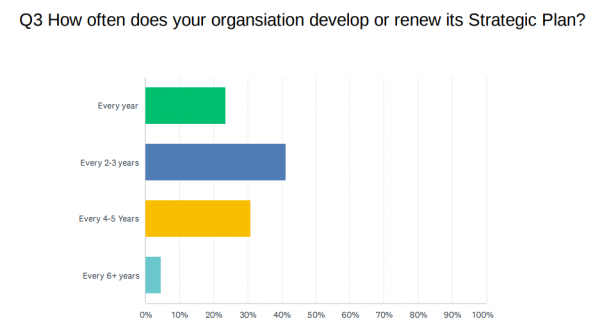Not-for-Profit Sector Strategic Planning: Inspiring and Implementing Strategy for Good
Over the past several years NFP Success has facilitated numerous small to medium sized not-for-profit organisation's strategic planning days, crafted strategic plans, and developed our own exclusive not-for-profit Do-it-Yourself Strategic Planning Kit. In addition, we also routinely survey Australian not-for-profit leaders to better understand and meet their needs. Our most recent survey and current data indicates that strategic planning is alive and well in the not-for-profit sector with 95% of those surveyed stating that they have a strategic plan in place, and most reviewing it at least every five years.

These data indicate that for the most part not-for-profits are being proactive and professionalising business practices, however, effective strategic planning remains a challenge, particularly as it relates to motivating organisations towards implementation. Of those surveyed 49% believe that their strategic plan generates inspirational impact upon the organisation, with the remainder considering it average or poor. When it comes to implementing their strategic plans, 75% indicate that their leadership team (Board, CEO, Senior Managers) do not refer to the plan more than three or four times a year. This same cohort reported that of their paid employees and volunteers 50% either didn’t know of its existence or refer to it sparingly.
This may point towards a strategic planning trend that tilts in favour of symbolic existence over functional use and suggests that for many organisations planning has become a ceremonial process. Perhaps this is partly due to the discipline of strategy and the term itself becoming widely overused and misunderstood. When reduced to first principles, strategy is essentially ‘how your organisation realizes its purpose and gets the job done’. In a sector crammed full of economic, political, and social challenges, not-for-profit sector leaders, employees and volunteers should theoretically be more intensely attuned with their strategic plans, but this does not seem to be the case.
To increase organisation wide engagement with the strategic plan, leaders embarking on their development journey, may benefit from first committing to a genuine process of transformation. Some markers of genuineness include scoping of the project to include all stakeholders, time, funding, resources, market (macro, meso, micro) analysis and engaging expert support and/or tools. Leaders who don’t invest seriously and are unwilling to respond to the data and intel, risk developing a drab and uninspiring document.
If one thinks about an age-old example of good strategy, in the Trojan war, one could be forgiven for surmising that the city of Troy was taken over by a simple wooden horse on wheels. Yet, upon deeper consideration what we find in the tale is a complex strategic innovation, designed to leverage the ancient conventions of war, religion, and politics by giving a gift that could not easily be refused. If your strategic plan isn’t creative, innovative, inspiriting, and unique to your service, then what exactly makes it strategic?
One way to ensure it is inspirational and engaging is to ensure it is inclusive. Unlike our friends in Homer’s Iliad, modern leaders have the luxury of gathering as much or as little strategic intelligence as they wish prior to acting. Our recent survey found that during strategic planning 38% of leaders did not consult staff or volunteers when developing their strategic plan. A further 17% did not survey their clients or stakeholders. Dave Ulrich and Jon Younger in their book HR from the Outside In, suggest that organisations that don’t continuously engage and include clients in their company decision making, will fail to adequately respond to internal and external market changes and inevitably be left behind. A good strategy is one that is porous to the clients and stakeholders, irrespective of your organisational size, if you don’t take the time to include them in the process your plan will fail them to some degree.
There is a Japanese proverb that says, “a plan with action is a daydream, but action without a plan is a nightmare”. If your organisation does manage to achieve a truly inspiring strategy on paper the next step is acting upon it. Our survey indicates that 40% of respondents do not have any element of their strategic plan which is regularly used as a measure of performance. For some organisations the notion of performance may be lacking in fashionable etiquette, however, a strategy that does not match style with substance quickly finds a new home on a dusty untouched bookshelf. Best practice prescribers to the maxim ‘what gets measured, gets done’ tend to cascade their strategic goals (set by the board) all the way down to their employees and volunteers. The very best ones celebrate and reward its achievement daily.
Perhaps the best illustration which encapsulates a good strategy in action, is found in the report that on an occasional visit to NASA the former U.S President John F. Kennedy, saw a cleaner who was carrying a broom down the hallway. The President then asked what his job was at NASA, and he replied, “I’m helping put a man on the moon.”








